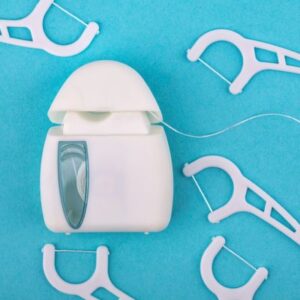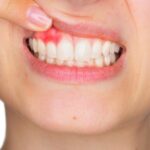
As dentists, we get this question every day: “Do I really need to floss?”
Short answer: yes—once a day. Flossing cleans the tight spaces your toothbrush can’t reach. It also helps to break up plaque before it hardens into tartar and irritates your gums.
If you do it right, flossing is quick, comfortable, and one of the best investments you can make in your smile.

Why Flossing Is Important
There are several reasons why you should be flossing. We know it gets those food particles out from between your teeth, but there are lots of reasons.
- Prevents cavities between teeth. Plaque hides where bristles can’t. Floss disrupts it before acids create decay.
- Protects your gums. Plaque along the gumline triggers gingivitis (red, puffy, bleeding gums). Consistent flossing helps stop it from progressing to periodontitis, which can lead to bone loss and loose teeth.
- Freshens breath. Trapped food and bacteria = odor. Flossing removes both.
- Supports long-term dental work. Crowns, bridges, implants, and orthodontic appliances stay healthier when the surrounding gums are clean.

What You’ll Need: Pick Your Tool
There’s no “one best” option—the best tool is the one you’ll use consistently.
- String floss (waxed or unwaxed): Classic, effective, great control. Waxed slides more easily through tight contacts.
- Dental tape: Flatter and wider; comfortable for wider spaces.
- Pre-threaded flossers (floss picks): Convenient on the go and for kids; use more than one per session so you’re not reusing a soiled strand.
- Super floss/tufted floss: Ideal around braces, bridges, and implants.
- Interdental brushes: Tiny brushes for larger spaces and around implants.
- Water flossers: Helpful add-on, especially with braces or dexterity issues. They’re a great supplement, not a full replacement for string floss for most people.

How Often (and When) Should You Floss?
Once a day is the sweet spot. If you get some food stuck in your teeth during the day, go ahead and floss.
- Timing: Whenever you’ll be consistent. Many patients prefer nighttime so teeth are clean while you sleep.
- Order: Brush or floss first—either works. Some people like to floss before brushing so fluoride can reach between the teeth more easily.

Step-by-Step Flossing Technique Tips
- Measure: Pull out about 18 inches of floss.
- Anchor: Wrap most around the middle finger of one hand; a little around the other middle finger. Use thumbs and index fingers to guide.
- Guide: Gently slide the floss between two teeth using a sawing motion. Don’t snap—it can injure your gums.
- Hug the tooth: Curve the floss into a C-shape against one tooth.
- Polish: Glide up and down 3–5 times from just under the gumline to the chewing edge. Then curve around the neighboring tooth and repeat.
- Advance: Move to a clean section of floss for each space. Don’t forget the back side of your last molars.
Some Questions our Patients Ask
What if my gums bleed when I floss?
That’s a common sign of gingivitis. Don’t stop—daily flossing plus good brushing usually calms bleeding within 7–10 days. If bleeding is heavy or persists, schedule a visit.
How long should flossing take?
About 2 minutes once you’re in the groove.
Can a water flosser replace string floss?
It’s an excellent helper, especially for braces and implants. Many patients do best using both. If manual flossing is truly a barrier, a water flosser is far better than doing nothing.
Which is better: waxed or unwaxed?
Whichever you’ll use every day. Waxed slides easier; unwaxed can squeak (a sign it’s clean).
Do I need to floss baby teeth?
Yes—if they touch. Establishing the habit early prevents cavities and teaches great technique.


